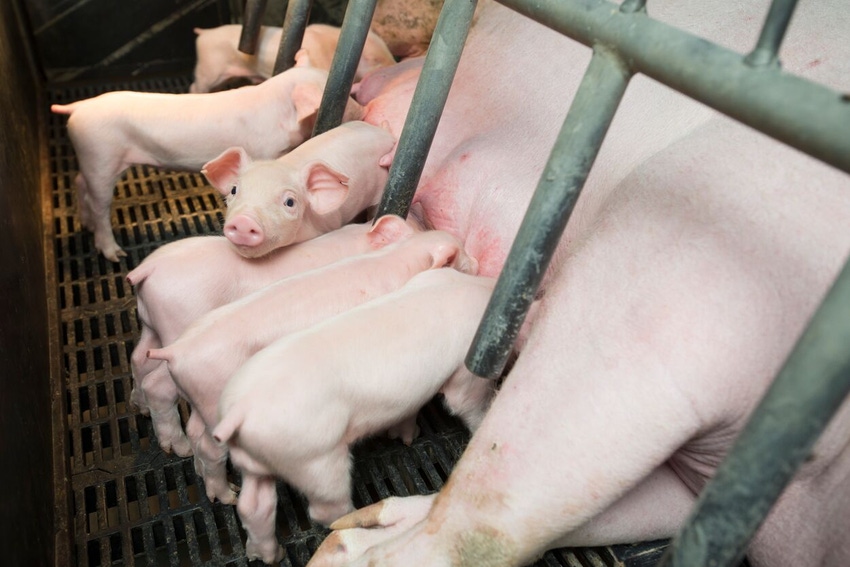Providing high dietary EFA improved average pig body weight at weaning and litter average daily gain during lactation.

When nutritionists think about supplemental fat, Julia Holen says they most often consider it as an energy source, but it is also providing essential fatty acids (EFA), primarily linoleic acid (LA) and alpha-linolenic acid (ALA), to the animal.
"From literature, we know that this can influence colostrum and milk composition, and in the past, researchers have found that providing dietary fat in mid-to-late gestation can also influence survivability of pigs," says the Kansas State University graduate student. "But we don't necessarily know if these fat sources fed shortly prior to farrowing can also influence piglet survival nor do we know necessarily how it might influence litter growth potential."
Thus, Holen and the Kansas State University swine nutrition team decided to conduct two studies to further evaluate essential fatty acid intake prior to farrowing and how this might influence both colostrum and milk composition as well as litter growth and survivability.
In the first study, the researchers evaluated feeding treatments at either day 107 or day 112 of gestation, and in these treatments, diets contained either high essential fatty acids through inclusion of soybean oil, or low essential fatty acids through inclusion of an animal fat source, such as beef tallow.
Holen says regardless of the timing of the treatments, whether sows began consuming diets at day 107 or day 112 of gestation, both colostrum and milk LA and ALA acid increased.
"When we include a high EFA source, the fatty acids are transferred efficiently to the mammary gland. So certainly, the diet fat content can influence colostrum composition as well as milk composition," Holen says.
To further understand how these changes may influence litter performance as well as sow reproductive performance and survivability, the K-State team partnered with Smithfield to evaluate the impacts of EFA intake on overall sow performance, litter growth performance and survivability and subsequent reproductive performance.
In this study, 3,451 mixed-parity sows were assigned to one of four treatments, with 850 to 874 sows per treatment. Sows entered the farrowing rooms at approximately day 112 of gestation and were assigned to one of the following treatments:
Control: 89 grams per day (g/d) of LA and 5 g/d of ALA (0.5% choice white grease )
Soy Oil: 189 g/d LA and 19 g/d ALA (3% soybean oil)
CWG: 109 g/d LA and 6 g/d ALA (3% choice white grease)
Combination: 205 g/d LA and 20 g/d ALA (3% soybean oil + 2% choice white grease)
Holen says it's important to note projected EFA intake for the Control and CWG diets were below North Carolina State University's recommended 125 LA g/d and 10 ALA g/d for lactating sows.
Based off of average daily feed intake and diet composition, the sows that were assigned to either the soybean oil and the Combination treatments consumed much higher LA and ALA compared to those with low dietary EFA in the Control and CWG diets.
"This response was important to validate that we did reach levels above the suggested recommendations from Rosero [NC State] and others for our projected high and low EFA intake treatments," Holen says.
Colostrum and milk samples were collected from a subset of sows within this study and the sows that were provided high EFA through soybean oil had significantly greater colostrum LA and ALA content. The improvement in LA and ALA content was maintained throughout the lactation period such that the milk also contained higher levels of the EFAs.
Holen says providing higher EFAs to the sows also resulted in overall improved average body weights of pigs at weaning.
"Pigs were a quarter of a pound to a third of a pound heavier when sow EFA intakes were above those levels recommended by Rosero whereas providing diets low in LA and ALA had lower weaning weights for those pigs," Holen says.
Examining piglet survivability within the first 24 hours and then from 24 hours through weaning, the researchers found no evidence for differences in piglet survival in the first 24 hours, nor were there differences in the remaining lactation period depending on the EFA intakes.
"We know that sow EFA intake can influence colostrum composition and milk composition throughout the lactation period, but we also know now that sow EFA intake did not influence farrowing performance, nor did it influence piglet's survivability," Holen says. "However, we did observe that sows provided high EFA produced litters with greater average daily gain and higher piglet body weights at weaning when compared to low."
The research team also followed these sows for subsequent reproductive performance and did not observe any evidence for differences in subsequent performance of sows in either farrowing rate or litter size in the subsequent litter.
About the Author(s)
You May Also Like





